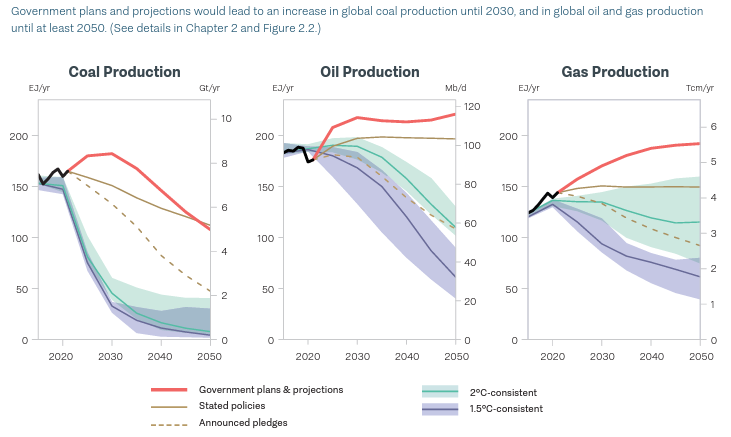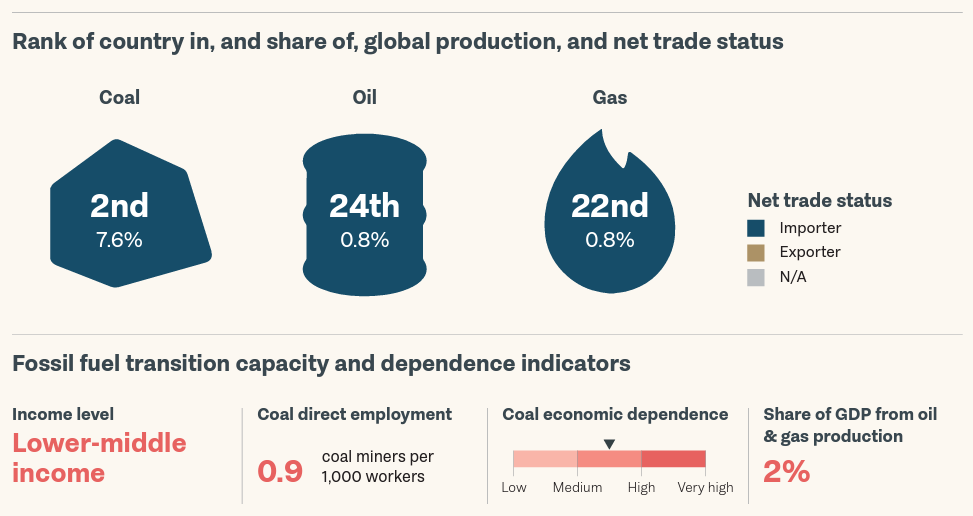Production Gap Report 2023 | 15 Nov 2023
For Prelims: Production Gap report, UN Environment Programme (UNEP), Paris Agreement, India's NDC
For Mains: Production Gap Report, Environmental Pollution & Degradation, Mineral & Energy Resources
Why in News?
Recently, Production Gap report 2023 has been published by the Stockholm Environment Institute (SEI), Climate Analytics, E3G, International Institute for Sustainable Development (IISD) and the UN Environment Programme (UNEP).
- The report assesses governments’ planned and projected production of coal, oil, and gas against global levels consistent with the Paris Agreement’s temperature goal.
- The production gap is the difference between governments’ planned fossil fuel production and global production levels consistent with limiting global warming to 1.5°C or 2°C.
What are the Key Findings of the Production Gap Report?
- Projected Increase in Fossil Fuels Production: Governments are planning to produce twice as much fossil fuel in 2030 than is compatible with the 1.5°C warming limit.

- This projection exceeds the 2°C target by 69%, emphasizing the pressing need for more ambitious climate action.
- Taken together, government plans and projections would lead to an increase in global coal production until 2030, and in global oil and gas production until at least 2050.
- This conflicts with government commitments under the Paris Agreement, and clashes with expectations that global demand for coal, oil, and gas will peak within this decade even without new policies.
- Major producer countries have pledged to achieve net-zero emissions and launched initiatives to reduce emissions from fossil fuel production, but none have committed to reduce coal, oil, and gas production in line with limiting warming to 1.5°C.
- India Specific Findings:
- India’s Updated NDCs:
- Emission Reduction: India's NDC aims to cut emissions intensity by 45% compared to 2005 levels by 2030.
- Renewable Energy Share: It targets 50% non-fossil power capacity by 2030.
- Long-term Vision: The updated NDC is a stride toward the 2070 net-zero emissions goal.

- Government's Stance on Fossil Fuel Production:
- Low-Carbon Transition with National Scale: The Long Term-Low Emission Development Strategy(LT-LEDS) released during COP27 commits to a low-carbon shift that preserves development needs.
- Emphasis is placed on maintaining energy security, access, and employment.
- Support for Domestic Fossil Fuel: An emphasis on self-reliance calls for the expansion of coal production to generate state income and job opportunities.
- Plans include scaling up domestic oil and gas exploration to meet increasing demand as the country's demand for gas is expected to rise by over 500% by 2030.
- The government has set up rolling electronic auctions of mining blocks to increase domestic coal production and is encouraging foreign direct investment in the oil and gas secto.r
- While investing in green energy, India maintains its commitment to fossil fuels, primarily coal.
- ONGC Videsh Ltd (OVL), a subsidiary of India’s national oil company, has stakes in 33 oil and gas projects in 15 countries (ONGC Videsh, 2023).
- Low-Carbon Transition with National Scale: The Long Term-Low Emission Development Strategy(LT-LEDS) released during COP27 commits to a low-carbon shift that preserves development needs.
- Government's Stance on Fossil Fuel Production:
- India’s Updated NDCs:
What are the Recommendations?
- Transparency in Plans: Governments should be more transparent in their plans, projections, and support for fossil fuel production and how they align with national and international climate goals.
- Adopt Fossil Fuels Reduction Targets: There is a strong need for governments to adopt near- and long-term reduction targets in fossil fuel production and use to complement other climate mitigation targets and to reduce the risks of stranded assets.
- Phase out of Fossil fuels: Countries should aim for a near total phase-out of coal production and use by 2040 and a combined reduction in oil and gas production and use by three-quarters by 2050 from 2020 levels, at a minimum.
- An equitable transition away from fossil fuel production must recognize countries’ differentiated responsibilities and capabilities. Governments with greater transition capacity should aim for more ambitious reductions and help finance the transition processes in countries with limited capacities.

